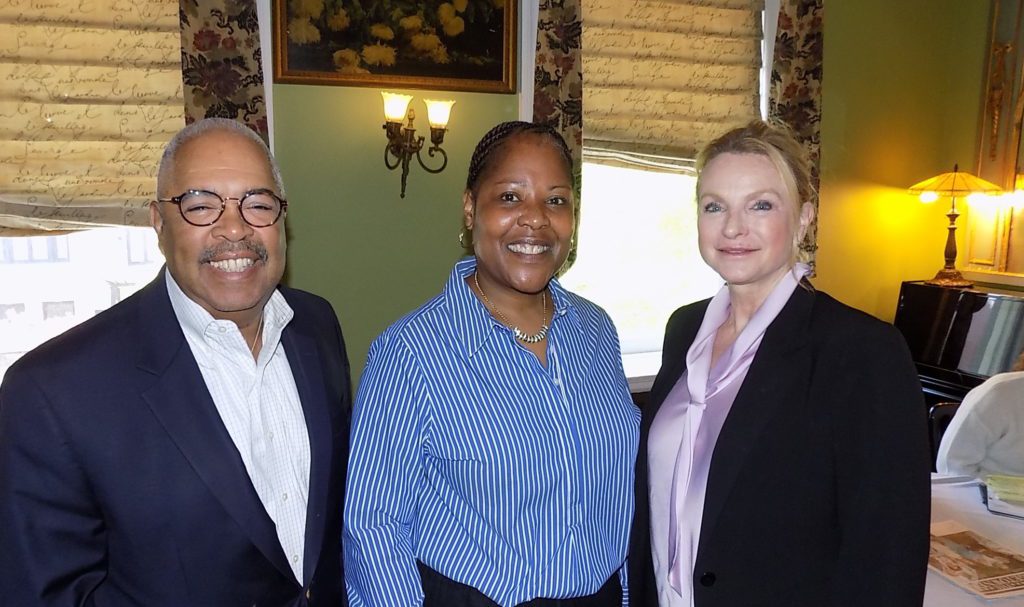Smithsonian’s Anacostia Museum Director Headlines Cultural Breakfast
By • May 23, 2022 0 2248

A few months after Dr. Melanie A. Adams started as director of the Anacostia Community Museum, in August of 2019, the museum reopened following renovations — only to shut down, with the other Smithsonian museums, in March of 2020.
The pandemic “really helped us double down on relevancy,” Adams said, giving attendees at The Georgetowner’s May 19 Cultural Leadership Breakfast at the Tabard Inn a taste of the New Jersey native’s positive attitude.
Though “so many museums were throwing all their content online,” the Anacostia Community Museum took a different approach. First, the public was asked to post online or call in stories of how they were coping, a project titled “Moments of Resilience.” Then, in 2021, a Smithsonian traveling exhibition was reimagined for outdoor display in Ward 7’s Deanwood neighborhood.
A frequent response to “Men of Change: Taking it to the Streets,” which profiled two dozen Black men from W. E. B. Du Bois to LeBron James, was: “We would never have seen this if it was at your museum.” What’s more, in partnership with the D.C. Public Library, a version of the exhibition was made available on 500 tablets at the Central Detention Facility.
Commenting on the “barriers when people think about museums,” Adams emphasized the need to create multiple points of entry. She noted that the Anacostia Community Museum, “a really small space,” is less intimidating than most. Average annual pre-pandemic attendance was about 35,000 — “like a weekend at Air and Space.” A “Covid-safe” way to connect with the nearby public is via the nature trail behind the museum, stewarded by the Ward 8 Woods Conservancy.
When the museum reopened for a few months in the summer and fall of 2021, a memorable moment for Adams was the arrival of nonagenarian Vivian Williams with her family to see “Food for the People: Eating and Activism in Greater Washington.” The exhibition described how Williams led a 1967 boycott of a supermarket chain that was raising prices on the day people in her predominantly Black neighborhood received benefit checks.
Adams, who previously held key positions at the Missouri and Minnesota Historical Societies, underscored that the Anacostia museum was founded in the 1960s by community organizers. Its first director, Southeast D.C. native John Kinard, told Smithsonian Secretary S. Dillon Ripley, who had the idea for a “storefront” branch, that rather than showcase loaned Smithsonian artifacts, the new facility, then in the vacant Carver Theater, would present what the community wanted to see.
Relevancy, impact and reach are the museum’s bywords, according to Adams, who added that she is “very big into themes.” The theme for 2021, extended into this year, was “Our Food, Our Future.” An Urban Adventure Kit was devised with celebrity chef and Howard University alumna Carla Hall. In June, an immigration-focused kit featuring José Andrés will be launched.
Aligning with concerns about food insecurity, the museum has provided space for the Feed the Fridge nonprofit to offer thousands of meals to neighborhood residents. About this kind of partnership, Adams quoted Smithsonian Secretary Lonnie G. Bunch III: “Museums are not community-centered, but they should be at the center of the community.”
That Bunch is considered the “Education Secretary” makes Adams a good fit; both her parents were New York City public school teachers and her University of Vermont master’s and University of Missouri–St. Louis doctoral degrees are in education. (Her University of Virginia bachelor’s degree is in English and African American studies.)
The museum’s 2022 theme is housing. An upcoming ACM-DCPL program, “Walking Cinema,” will be a 30-to-40-minute augmented reality walking tour of Southwest D.C. through the eyes of a resident and an urban planner. The tour is part of a focus on gentrification, calling attention to how African American neighborhoods continue to be “erased.”
Adams said the museum is working with an outside firm to define its core audience and find ways to have more of an impact, asking questions such as: “What does a school field trip look like?” In response to an attendee’s question about how to pursue relevance, she gave the example of four young “activators” being hired to enhance the museum’s social media engagement. Also of note, in-person programs will resume in June with the return of “Craftivism” sessions on the first Saturday of every month.

